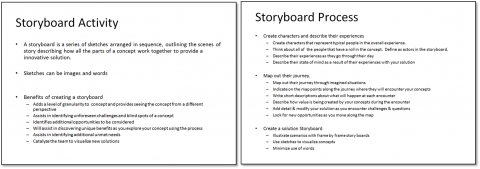Hack:
Accelerating Concept Development: How to rapidly test a concept!
Accelerate the concept development process by “prototyping” your concept in 30 minutes or less!
This article was written as one of the requirements to obtain the Innovation Mentor Certification at CIMp. The CIMp program is part of iVia, The Way of InnovationTM, founded by The University of Notre Dame, Whirlpool Corporation, and Beacon Health System.
Learn more at http://innovationcertification.nd.edu/
Innovation teams could benefit from tools to assist them in quickly testing their hypotheses and iterating their concepts. Historically, creating a “prototype” has been a tool that teams could leverage. “Prototyping” can range from creating the simplest concept mockup to building a fully featured and functional physical object. For many companies, a “prototype” has typically meant something physical, a part that they can touch or feel, or a piece of software that can be tested. However, when teams prematurely focus on the physical attributes of a concept, key issues or “blind spots” can often be overlooked. Additionally, creating an elaborate physical prototype can consume precious project resources and can often lead teams to focus on testing functionality and performance characteristics long before the value proposition has been confirmed. Certainly creating a functional prototype is a key milestone in a project, however…
How might we accelerate identifying opportunities to improve our concept without expending significant resources and consuming precious project time that is often required for building a typical physical prototype?
How might we present our concept to leadership in unique and exciting way?
Try creating a storyboard!
Creating a storyboard is a great tool that can be leveraged to assist teams in the early phases of a project. In this context, a storyboard is quite simply a series of sketches describing the interaction of people (can be customers, users, or other main players) with the concept. The process of creating the storyboard encourages the team to step back from defining the intricate physical details and focus on how people will interact with the potential innovation. Through the process of creating a storyboard, your team is likely to identify issues with the concept as well as potential opportunities that were previously overlooked. Finally, the simplicity of this tool allows it to be applied to a wide range of projects from product or process development to business model innovation.
Creating a storyboard provides the team with a different perspective for analyzing their concept beyond typical discussion or brainstorming. In practice, I have found that the storyboard creation process provides the following benefits.
- The process encourages the team to understand how people interact with the concept from end to end.
- You will likely discover unique benefits as you explore your concept using the tool.
- You will likely discover additional unmet needs when creating a storyboard.
- You may identify blind spots or things that you have missed that lead to additional research or discovery; possibly an opportunity for another innovation solution.
- Facilitates the testing of basic concept assumptions that need to be validated.
- Quickly prototyping your ideas can aid in preventing your team from becoming emotionally attached to a concept and losing objectivity in the concept evaluation phase.
- The tool can be a catalyst for your team to visualize new solutions.
- Assists your team in learning “what needs to be true” for your concept to succeed.
As with any tool or process, storyboarding can present some challenges to the team as well.
- Some people may not like to draw, that’s OK; storyboards don’t have to be museum quality artwork. Remember, you are simply trying to review the concept from a different perspective. The magic comes from the process of creating the storyboard, not from the resulting images.
- Resist the urge to use the tool too early in the process. During the Discovery or Research phase of a project, it is important for teams to remain objective in their activities. I typically introduce this tool during the later stages of an ideation event to assist teams in developing their concept.
- Sometimes people do not give credit to this type of intuitive exercise. Something so simple is often overlooked or dismissed when we are looking for the flashy tools to implement in an ideation session.
- Certainly not all individuals will see the value in this process. That is OK too; this is simply a tool for the toolbox. However, consider this example of the first time I was exposed to this process during the CIMp program.
We were working on a concept that required a key piece of software to be developed. Many of the individuals on the team (including myself) quickly jumped to trying to prototype the software. We were very focused on simulating the software’s functions and features. Fortunately, we were working with some great individuals from the Gravity Tank. They skillfully facilitated us to focus on the interaction people would have with the software rather than focusing on the features of the software itself. They defined this activity as “creating a storyboard”. This was a great experience because it showed we could “prototype” our concept in 30 minutes when many on the team expected weeks or even months for beta software.
Creating a storyboard is a simple activity, it doesn’t take a lot of time and is very effective when leveraged during an ideation event… Here’s a quick summary of how I have leveraged the tool on past projects.
Planning for Success….
- When planning your next ideation event, simply carve out 30 minutes for a storyboard activity. Although 30 minutes may seem quite short, I have found that short duration activities helps keep the team focused and on task.
- I have also found that this activity works best in smaller groups. I would suggest groups no larger than 7. If you have 8 or more team members, break into two teams and have them work independently with a session to share the stories upon completion.
- Create a slide to introduce the activity and explain the storyboard process as well as a slide to provide directions. See the examples shown below. A template has been included in the Documents section.

Execution…
- Present your team with large sheets of paper and writing utensils.
- Present them with a copy of the instructions for the breakout room or keep the instruction slide displayed for the group to refer back to.
- Finally, have the team present the storyboard to an audience for feedback and further refinement of the concept.
Facilitator’s notes…
- Remember, the key to the activity is not the images that are created; it is the process that the team will go through to create them.
- Encourage your team to create and define people or characters for their storyboard. This will result in significantly more engagement and interaction.
- Ensure that your team maintains focus on high-level interactions of people with the concept versus subtle details or physical attributes of the concept itself.
- Minimize but don’t eliminate the use of written words. Images stimulate thinking about a problem in a different manner. Also encourage the use of color when creating the images.
- During the activity, leverage a parking lot (a separate easel / notepad / white board) to document challenges or unmet needs as they are identified.
I was fortunate to work with some great facilitators from the Gravity Tank who introduced me to this tool during the CIMp program. www.gravitytank.com
101 Design Methods by Vijay Kumar. The author presents Concept Sketches and Concept Scenarios on pages 222, 224 of his text providing a summary of benefits as well as a guide for using the tools.
Design Research 101: Prototyping Your Service with a Story Board by Alissa Millenson. http://www.peerinsight.com/musings/2013/5/30/design-research-101-storyboards
Show, Don’t Tell: Why We Storyboard in the Concept Development Process. http://www.worrell.com/newmagazine/articles/2015/show-dont-tell
Storybarding in the Software Design Process by Ambrose Little. http://uxmag.com/articles/storyboarding-in-the-software-design-process
CIMp program of iVia.
iVia, The Way of InnovationTM.
Founded by The University of Notre Dame, Whirlpool Corporation and Beacon Health System.
Learn more at http://innovationcertification.nd.edu/



You need to register in order to submit a comment.